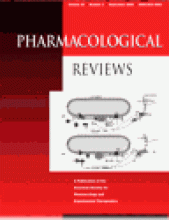The following is a corrected version of information that appeared in vol. 49 of Pharmacological Reviews [Hinderling PH (1997) Red blood cells: A neglected compartment in pharmacokinetics and pharmacodynamics. Pharmacol Rev
49:279–295]. The author apologizes for any inconvenience this error may have caused.
Drugs may bind to constituents in the RBCs and plasma. It is assumed that one class of drug binding sites exists in both RBCs and plasma. The concentration in the RBCs for drugs lipophilic enough to pass the RBC membrane is given by:Ce=Cp,u·I1+n·Et/KD,e1+(Cp,u·I/KD,e)
Equation 5where n · Et corresponds to the total binding site concentration in the RBCs, Kd,e represents the association constant and I is a constant relating the unbound drug concentration in the aqueous phase of the RBCs and Cp,u. As indicated above, the restricted volume of the aqueous phase of the RBCs compared to that in plasma or buffer available for distribution of the unbound drug, the impact of the Donnan equilibrium and the pH difference between the aqueous phases in the RBCs and plasma or buffer require the introduction of this constant.
For hydrophilic drugs that only bind to the outer part of the membrane without actually passing it, Ce is defined by eq. 6:Ce=Cp,un·Et/KD,e1+Cp,u/KD,e
Equation 6The total drug concentration in plasma is defined by:Cp=Cp,u1+n·Pt/KD,p1+Cp,u/KD,p
Equation 7where n · Pt and Kd,p correspond to the total binding site concentration in plasma and the association constant, respectively.
Combination of eqs. 5 and 7 yields the following expression for Ke/p of compounds of sufficient lipophilicity:Ke/p=I1+n·Et/KD,e1+I·Cp,u/KD,e1+n·Pt/KD,p1+Cp,u/KD,p
Equation 8The corresponding equation for hydrophilic compounds is: Ke/p=n·Et/KD,e1+Cp,u/KD,e1+n·Pt/KD,p1+Cp,u/KD,p
Equation 9Equations 8 and 9 are nonlinear and predict that if I · Cp,u or Cp,u exceeds a critical value, binding of a drug to the sites in the RBCs and/or in plasma becomes saturable. Hence, Ke/p will not be constant and either decreases or increases with increasing I · Cp,u or Cp,u.
Special cases for sufficiently lipophilic compounds can be differentiated using eq. 8 as follows: (a) both binding sites in RBCs and in plasma are saturated: I · Cp,u ≫ Kd,e and Cp,u ≫ Kd,p:Ke/p=I1+n·EtI·Cp,u1+n·PtCp,u=I for Cp,u→∞
Equation 10(b) both binding sites in RBCs and plasma are unsaturated: I · Cp,u ≪ Kd,e and Cp,u ≪ Kd,p: Ke/p=I1+n·EtKD,e1+n·PtKD,p=constant
Equation 11(c) only binding sites in RBCs are saturated: I · Cp,u ≫ Kd,e and Cp,u ≪ Kd,p: Ke/p=I1+n·EtI·Cp,u1+n·PtKD,p
Equation 12
=I1+n·PtKD,p for Cp,u→∞
(d) only binding sites in plasma are saturated: I · Cp,u ≪ Kd,e and Cp,u ≫ Kd,p: Ke/p=I1+n·EtKD,e1+n·PtKD,p
Equation 13
=I1+n·EtKD,e for Cp,u→∞
- The American Society for Pharmacology and Experimental Therapeutics






